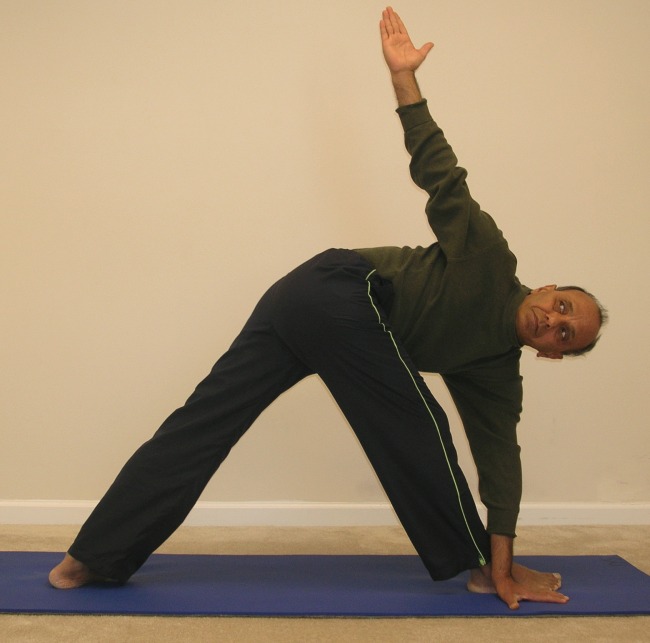Parivritta Trikonasana (Revolving Triangle Pose) – परिवृत्तत्रिकोणासन –
When you see a picture of this pose, it may look deceptively simple. However, you realize some of the challenges involved in getting into the pose once you start working with the pose.
You may also find that, like many other poses, you can go deeper into the pose in one direction compared to the other. This is just indicative of the normal imbalances that we have in our body (and the mind and emotions) which should gradually diminish with constant practice.
Step-by-step
It is best to start out as if you are preparing for the Parshvottanasana (intense side stretch).
- Come to a standing position close to the top of the mat with the feet hip distance apart. Stretch your left leg back so the feet are about 3.5′ to 4′ apart. Keep the right foot facing the front with the side of the foot parallel to the side edge of the mat. Keep the left foot turned about 60 degrees toward to the front foot. Try to keep both the legs straight.
- Place the hands on the waist and turn the hips and shoulders so they are parallel to the top edge of the mat. Keep the back heel firmly pressed into the mat.
- Place the hands on the right thigh and start sliding them down the leg. Make the effort to keep the right leg as straight as possible. Try to bend the torso at the waist area. Press the thighs backward so the torso stays elongated and pushed forward.
- Maintain the intention to keep the right leg straight. However, if the hamstrings begin to complain, you may like to bend the right knee slightly so as to avoid overstretching the back side of the leg.
- While still bending over the right leg, we are going to add the twisting movement of the spine. Start by placing the right hand on the right hip and try to bring the left hand on the outside of the right foot and place it flat on the floor.
- For a beginner it may be challenging to place the hand on the floor. If readily available, you may like to use a block placed on the outside of the foot and rest your hand on the block.
- Try to rotate the hips and the torso so the hips are eventually facing the side edge of the mat.
- If this movement poses a balancing challenge, you can try bringing the block on the inside of the right foot and then try to turn the hips around to the right.
- If a block is not available, you may just keep the hand on the shin or wherever comfortable on the leg.
- Once the hips and the torso are turned, you may attempt to raise the right arm all the way up to a vertical position. Again, if this poses a challenge in maintaining balance, you may keep the hand on the waist.
- Also, if it becomes difficult to maintain the left heel firmly on the mat, you may lift the heel slightly or place the heel on a rolled up mat or a cushion to keep the pose comfortable.
- In the final position, both the arms and shoulders are in a single vertical plane. Turn the neck to look up at the right thumb.
- Stay in the final pose for almost a minute, if comfortable.
- To come out of the pose, release the right hand down, turn the body around to face the front and come back to a comfortable standing position. Relax for a few breaths.
- Repeat the above moves, reversing the position of the legs.
Benefits
Parivritta Trikonasana combines the benefits of a spinal twist, balancing pose and a hip opening pose.
- Stretches and strengthens the calf muscles, hamstrings, legs and thighs
- Stretches and opens the hips
- Great stretch for the full length of the spine
- Opens up the chest and lungs for better breathing
- Stimulates and massages the abdominal organs, particularly the liver, pancreas and the intestines
- Helps with digestion and constipation
- Helps with mild lower and upper back pain
- Improves physical balance and mental focus
Contraindications and Cautions
- If you have recent back injury and are experiencing back pain, seek the guidance of an experienced yoga teacher before practicing this asana
- In case of shoulder pain, keep the hand on the waist rather than raising it up vertically
- In case of neck pain, avoid looking up; instead keep the gaze horizontal, straight ahead
- If you have low blood pressure, avoid bringing the head below the level of the heart
I would love to hear about your own experience with this pose. Please post your comments below in the comment box.

Recent Comments